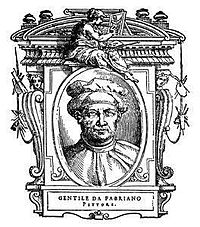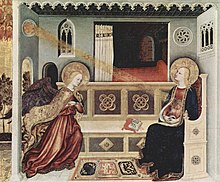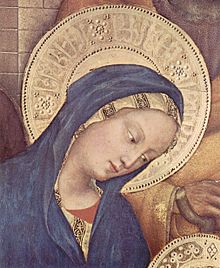art.wikisort.org - Artist
Gentile da Fabriano[lower-alpha 1] (c. 1370 – 1427) was an Italian painter known for his participation in the International Gothic painter style. He worked in various places in central Italy, mostly in Tuscany. His best-known works are his Adoration of the Magi from the Strozzi Altarpiece (1423), and the Flight into Egypt. Following a visit to Florence in the 1419, he came in contact with humanism, which influenced his work throughout the rest of his career.[4] He became highly influential for other painters in Florence, especially because of his use of detail based on the observations he made of the natural world.[5]
Gentile da Fabriano | |
|---|---|
 Gentile da Fabriano, in a portrait by Giorgio Vasari | |
| Born | Gentile di Nicolò di Giovanni c. 1370 Fabriano, Papal States |
| Died | 1427 (aged 56–57) Rome, Papal States |
| Nationality | Italian |
| Known for | Painting |
| Notable work | Adoration of the Magi |
| Movement | International Gothic |
Bibliography

Early life in Fabriano (c. 1370-1400)
Gentile (di Niccolò di Massio) da Fabriano was born around 1370 in or near Fabriano, in the Marche.[6] Despite having several family members who took part in different civic and religious organizations in the city, much of Gentile's early life remains undocumented.[6] His mother died some point before 1380, and his father, Niccolò di Giovanni Massi, retired to a monastery in the same year, where he later died in 1385.[7] Little is known of his educational formation: one of his first known works, a Madonna and Child (c. 1395–1400, now in Berlin) shows the influence of paintings made in the northern Italian late-Gothic style.[8] Around 1390 Pavia resided at the court of Gian Galeazzo Visconti, where there is a table with the Madonna with the Children together with the saints Clara and Francis (now in the Pavia Civic Museums) and some frescoes depicting ladies inside a room of the Visconti Castle.[9]
Venice (c. 1405-1420)
By around 1405, Gentile da Fabriano was working in Venice.[10] He painted a panel for the church of Santa Sofia, now lost; Jacopo Bellini worked perhaps in his workshop.[6] Between 1408 and 1409, he painted a fresco (now lost) in the Doge's Palace depicting the naval battle between the Venetians and Otto III. In Venice, he knew Pisanello and perhaps Michelino da Besozzo.[10] He also produced commissions for other cities during this period, such as his Madonna and Child (c.1405-1410) for a church in Perugia.
In 1410–1411, Gentile was in Foligno, where he frescoed some of the walls of the Palazzo Trinci. Gentile met painter Michelino da Besozzo in Venice and became inspired by his rhythmic and sophisticated style.[6] Around 1410–1412, he painted one of his first masterworks, the Valle Romita Polyptych (now at the Pinacoteca di Brera). The altarpiece was probably commissioned by Chiavello Chiavelli upon its completion in 1412. In 1414, he moved to Brescia, at the service of Pandolfo III Malatesta, and painted the Broletto Chapel, a work now mostly lost, for the next five years. While in Brescia in 1418, Gentile painted another panel that was later given as a gift to Pope Martin V, who had passed through the city on his way to Rome.[6]

Florence
On 6 August 1420, Gentile was in Florence,[10] where he painted his famous altarpiece depicting the Adoration of the Magi (1423) commissioned by Palla Strozzi.[11] This work, which is now in the Uffizi, is regarded as one of the masterpieces of the International Gothic style and had a lasting influence on Italian Renaissance painting.[6] This work also demonstrated his improved naturalistic technique that used light to create dimensions and perspective.[6] His use of contrasting light brought the figures to life, making them appear more naturalistic human.[6] His other works in Florence include the Intercession Altarpiece (1420-1423) and the Quaratesi Polyptych (May 1425). In June–August 1425, he was in Siena, where he painted a Madonna with Child, now lost, for the Palazzo dei Notai in Piazza del Campo. Between August 1425 and October of the same year, he was in Orvieto, where he painted his fresco of the Madonna and Child in the Cathedral, where it still remains today. The work has, however, been restored since its original painting. Also sometime between 1420 and 1425, Gentile painted another work, an Annunciation, in the Vatican Pinacoteca.[12] This painting contains a number of unique features and uses light to visualize the ut vitrum metaphor, which creates glass-like images.[12] Gentile also demonstrates this technique in the predella. The Nativity scene contains three different sources of light (the moon, the angel above and the Christ child) to form the first realistic depiction of night in Renaissance art.[6]

Rome (1427)
In 1427 Gentile arrived in Rome. There, he was commissioned by Pope Martin V to decorate the nave of the Basilica of St. John in Lateran. However, Gentile is known to have died later in the year sometime before 14 October 1427. The nave would later be completed by Pisanello after Gentile's death. Gentile is commonly said to have been buried in the church now called S. Francesca Romana in Florence, but his tomb vanished; there is evidence, however, that he may be buried in the church of Santa Maria in Trastevere, in Rome.[7]
Islamic Influence: Mamluk Metalwork

The Mamluk Sultanate is well-known for its production of metalwork objects, most of which include inscriptions in Arabic script.[13] By the late thirteenth century, artists like Duccio and then later in the early fifteenth century, Gentile da Fabriano, were influenced by these types of Mamluk metalwork pieces and started to incorporate their patterns and motifs into their paintings.[14] In Gentiles da Fabriano's Adoration of the Magi (1423), pseudo-Kufic Inscriptions line the cloaks of several figures.[13] Pseudo-kufic inscriptions also appear in the bold, ornamented halo of the Virgin Mary and Joseph, which are divided into four equal parts by rosettes, are also seen in the Mamluk plates.[15] An example of a Mamluk plate of the time is the Mamluk Philae Dish (c. 1345-1360), where four rossetts divide the Arabic script into quadrants.[16]
Halos with pseudo-kufic inscriptions are reflected in several of Gentile da Fabriano's paintings that were produced during his time in Florence including: Coronation of the Virgin (Gentile da Fabriano) from around 1420 and a Madonna with Child and Angels that is part of the Quaratesi Polyptych (May 1425). Moreover, Gentile da Fabriano's use of halos with pseudo-kufic inscriptions influenced other artists, including painter Masaccio, who began his use of pseudo-kufic halos as early as 1422, and can be seen later in his Pisa Altarpiece from 1426. Venice was among the early important centers of trade for Islamic goods in Europe, and in turn, traditional Islamic forms were highly desired by European patrons because of their associations with "exotic" Other of Jerusalem and the Holy Land.[17] Halos painted with patterns based on Mamluk metalworks reveal the types of commercial and artistic exchanges that were taking place in other Italian city-states, like Florence.[18] The fact that Florence secured two major seaports, Pisa and Livorno, in 1406 and 1421 respectively, illustrates the increased diplomatic ties between the Florentines and Mamluks.[18]
Notes
References
- "Gentile da Fabriano" (US) and "Gentile da Fabriano". Lexico UK English Dictionary. Oxford University Press. Archived from the original on 2020-09-30.
- "Gentile da Fabriano". The American Heritage Dictionary of the English Language (5th ed.). HarperCollins. Retrieved 1 June 2019.
- "Gentile da Fabriano". Merriam-Webster Dictionary. Retrieved 1 June 2019.
- Panczenko, Russell (1983). "English Summary of Gentile da Fabriano and Classical Antiquity". Artibus et Historiae. 4 (8): 167–68. JSTOR 1483219.
- "Gentile da Fabriano".
- Wohl, Hellmut (2003). "Gentile (di Niccolò di Massio) da Fabrianoo". Gentile (Di Niccolò di Massio) da Fabriano. Grove Art Online. doi:10.1093/gao/9781884446054.article.T031359. ISBN 9781884446054.
- Wohl, Hellmut (2003). Gentile (di Niccoló di Massio) da Fabriano. doi:10.1093/gao/9781884446054.article.T031359. ISBN 978-1-884446-05-4.
- Vasari, Giorgio (2008). Lives of the Most Eminent Painters Sculptors & Architects. London: Philip Lee Warner. pp. 107–117.
- Cairati, Carlo (2021). Pavia viscontea. La capitale regia nel rinnovamento della cultura figurativa lombarda. I. Il castello tra Galeazzo II e Gian Galeazzo (1359-1402). Milano: Scalpendi Editore. pp. 181–184. ISBN 9791259550187.
- Panczenko, Russell (1983). "Cultura umanistica di Gentile da Fabriano". Artibus et Historiae. 4 (8): 27–75. doi:10.2307/1483214. JSTOR 1483214.
- Mack, Rosamond E. (2001). Bazaar to Piazza: Islamic Trade and Italian Art, 1300-1600. University of California Press. pp. 63–65. ISBN 0520221311.
- Hodne, Lasse (2014). "Light Symbolism in Gentile da Fabriano's Vatican Annunciation". 3 (2): 33–49.
{{cite journal}}: Cite journal requires|journal=(help) - Christian, Kathleen (2017). European Art and the Wider World 1350-1550. Manchester University Press. pp. 29–33.
- Mack, Rosamond E. Bazaar to Piazza: Islamic Trade and Italian Art, 1300-1600. University of California Press. pp. 63–65. ISBN 0520221311.
- Mack, Rosamond E. Bazaar to Piazza: Islamic Trade and Italian Art, 1300-1600. University of California Press. pp. 63–65. ISBN 0520221311.
- "Mamluk Philae Dish". The MET.
- Christian, Kathleen (2017). European Art and the Wider World 1350-1550. Manchester University Press. pp. 29–33.
- Christian, Kathleen (2017). European Art and the Wider World 1350-1550. Manchester University Press. pp. 29–33.
Sources
- Mack, Rosamond E. (2001). Bazaar to Piazza: Islamic Trade and Italian Art, 1300–1600. University of California Press. ISBN 0-520-22131-1.
- Gentile da Fabriano e l'altro Rinascimento, catalogo della mostra (in Italian). Fabriano: Electa. 2006. Exposition lasting 21 April–23 July 2006.
- Marcelli, Fabio (2005). Gentile da Fabriano (in Italian). Silvana.
- De Marchi, Andrea (1992). Gentile da Fabriano. Un viaggio nella pittura italiana alla fine del gotico (in Italian). Federico Motta (published 2006).
- Łada, Justyna (2004). Obraz Maryi z Dzieciątkiem Gentile da Fabriano jako przykład typu Madonny (in Polish). Roczniki Humanistyczne KUL.
External links
- Gentile da Fabriano biography-paintings-curiosity-publications
- Italian Paintings: Sienese and Central Italian Schools, a collection catalog containing information about Fabriano and his works (see index; plates 34-35).
- 5 paintings of Gentile da Fabriano
- Gentile da Fabriano at the National Gallery of Art, Washington DC
На других языках
[de] Gentile da Fabriano
Gentile da Fabriano (eigentlich Gentile di Nicolò Massio, * um 1370 oder um 1385 in Fabriano; † 1. August 1427 in Rom) war ein italienischer Maler der Spätgotik, von dem Michelangelo sagte, er male ähnlich wie er heiße[1]. Er ist zugleich einer der Hauptvertreter der höfischen Stilrichtung um 1400 in Italien.- [en] Gentile da Fabriano
[es] Gentile da Fabriano
Gentile da Fabriano (Gentile di Niccolò di Giovanni Massi; Fabriano, h. 1370 – Roma, 1427) fue un pintor italiano, uno de los principales exponentes del estilo gótico internacional en Italia. Encarnó en su siglo la típica figura del artista itinerante, que prefería moverse para encontrar las más variadas ocasiones de trabajo ofrecidas por las cortes antes que quedarse establecido en un taller. Su pintura poética y fabulosa, el gusto por la línea y un uso incomparable de los elementos decorativos lo llevaron a la cúspide de la escuela italiana de la época, recibiendo encargos de grandísimo prestigio. Al visitar Florencia, entró en contacto con el naciente Humanismo en el arte y, aunque sin renunciar al estilo propio, inició una consciente transición entre el decorativismo tardogótico y la esencia renacentista.[1][fr] Gentile da Fabriano
Gentile di Niccolò di Giovanni Massi, dit Gentile da Fabriano (né à Fabriano, ou à proximité, dans la province d'Ancône dans les Marches, vers 1370 et mort à Rome en 1427) est un peintre italien connu pour sa contribution au style Gothique international italien.[it] Gentile da Fabriano
Gentile di Niccolò di Giovanni di Massio, detto Gentile da Fabriano (Fabriano, 1370 circa – Roma, settembre 1427), è stato un pittore italiano. Tra i più importanti esponenti del Gotico internazionale, incarnò nel suo secolo la tipica figura dell'artista itinerante, che preferiva spostarsi per trovare le più svariate occasioni di lavoro offerte dalle corti piuttosto che stanziarsi a bottega. La sua pittura poetica e fiabesca, il gusto per la linea e un uso impareggiabile degli elementi decorativi lo portarono al vertice della scuola italiana dell'epoca, ricevendo commissioni di grandissimo prestigio. Con la visita a Firenze entrò in dialogo con il nascente umanesimo nell'arte e, pur senza rinunciare al proprio stile, iniziò una consapevole transizione tra il decorativismo tardogotico e l'essenzialità rinascimentale[2].[3][ru] Джентиле да Фабриано
Джентиле да Фабриано (итал. Gentile da Fabriano, собственно итал. Gentile di Niccolò di Giovanni Massi, ок. 1370, Фабриано, провинция Анкона — сентябрь 1427, Рим) — итальянский живописец, крупнейший представитель интернациональной готики в Италии.Другой контент может иметь иную лицензию. Перед использованием материалов сайта WikiSort.org внимательно изучите правила лицензирования конкретных элементов наполнения сайта.
WikiSort.org - проект по пересортировке и дополнению контента Википедии